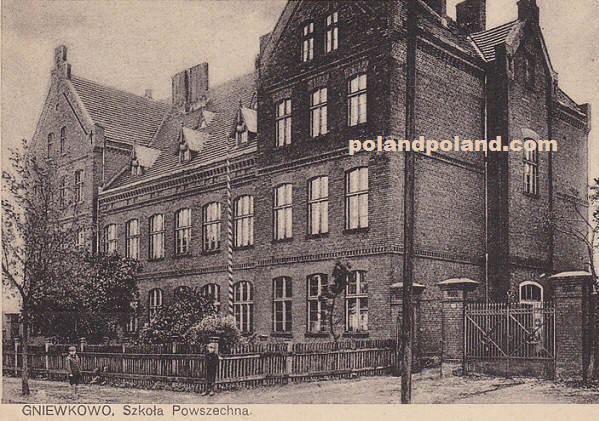Gmina Gniewkowo Town rights 1268 Area 9.18 km² Local time Wednesday 8:18 PM | Established 12th century Time zone CET (UTC+1) Population 7,254 (2006) | |
 | ||
Weather 7°C, Wind W at 13 km/h, 56% Humidity Voivodeship Kuyavian-Pomeranian Voivodeship | ||
Gniewkowo [ɡɲefˈkɔvɔ] (German: Argenau) is a town in Inowrocław County, Kuyavian-Pomeranian Voivodeship, Poland with a population of 7,301 (2005).
Contents
Map of Gniewkowo, Poland
Location
Gniewkowo is located to the south of the Bydgoszcz forest on route 52, 15 km northeast of Inowrocław and 23 km southwest of Toruń.
History
Archaeological excavations have shown that the site was already populated by the Bronze Age. The first historical mention of the town dates from 1185. In 1268 the town was granted city rights. In 1314 Siemomysł of Inowrocław’s largeer Kuyavia duchy was divided among his three sons; Casimir inherited the Gniewkowo region which became a small autonomous duchy. The Teutonic Knights laid siege to Gniewkowo in 1332 during their war with Poland. To avoid capture Casimir set fire to his Grad (Slavic settlement) and abandoned the town. He would not regain control of the duchy until the Treaty of Kalisz in 1343.
In 1364/1365, Władysław the White mortgaged Gniewkowo to Casimir III the Great. In 1408 the city hosted a meeting between Jogaila and the Teutonic Knights over the disputed Dobrzyń territory. From 1409 to 1411 Gniewkowo played an important role in the conflict between Poland and the Teutonic Order.
Gniewkowo was ravaged by several fires during the 16th century, limiting its development. During the 17th and the 18th centuries, wars with Sweden and subsequent outbreaks of diseases laid waste to the town.
Gniewkowo was annexed by Prussia in 1772 after the first partition of Poland ( but from 1807 to 1815 Gniewkowo was part of the Duchy of Warsaw), during which time the economy began to develop. Starting in 1843, a road linked the city to Inowrocław and Toruń. Jews and Germans became more and more prominent, while the local Polish population suffered from an official policy of discrimination and forced Germanization. In 1879 the German Imperial administration, following the Bismarck's policy of forced Germanization of ancient Polish territories and their Slavic peoples, changed the name of the town to a German "Argenau." A general strike broke out after German became the required official language for religious classes. Electricity became available citywide in 1908.
On January 17, 1920, after a year of fighting, Gniewkowo rejoined a newly independent Poland. The town suffered greatly during the Polish economic crisis that followed World War I. On the eve of World War II the unemployment rate was 70%.
During World War II 4,000 civilians taken from Gniewkowo and the nearby towns of Inowrocław, Bydgoszcz and Toruń were executed by the Nazis in the woods surrounding the town.Red Army took Gniewkowo on January 21, 1945 and thus begun the 44 years of Communist Poland. In 1989 first, since 1939, free and democratic electione were held in Gniewkowo as in the rest of democratic Republic of Poland. Between 1978 and 1998 Gniewkowo belonged to Bydgoszcz Voivodeship and since the 1998 administrative reform belongs to Kuyavian-Pomeranian Voivodeship.
Economy
Local companies:
